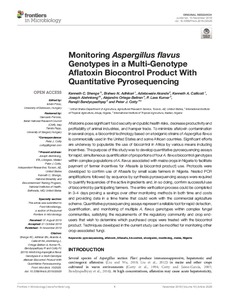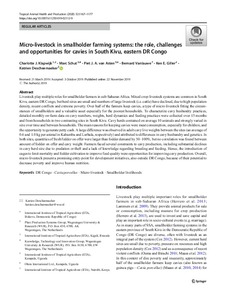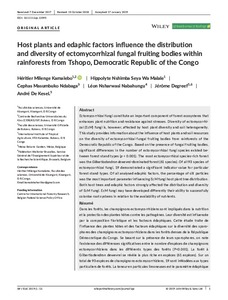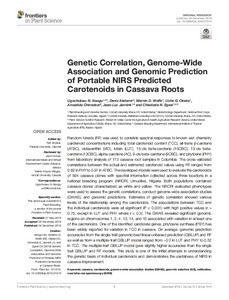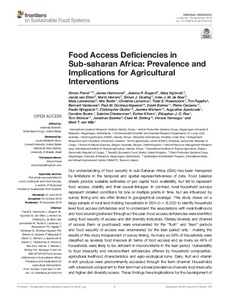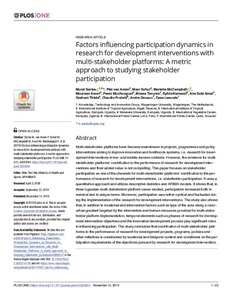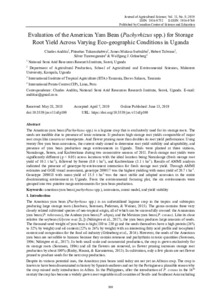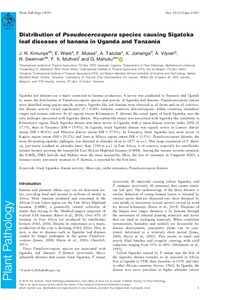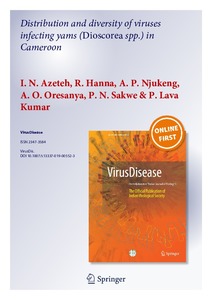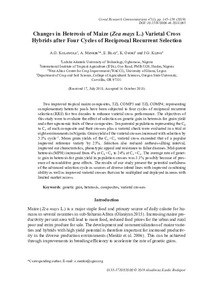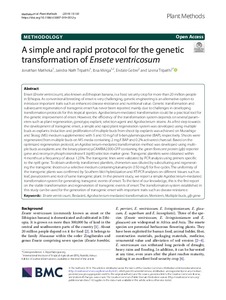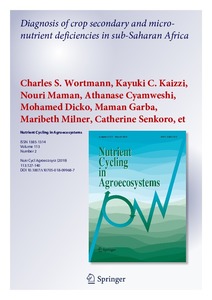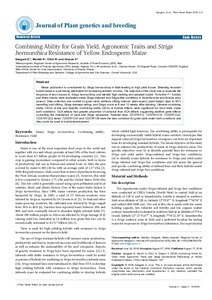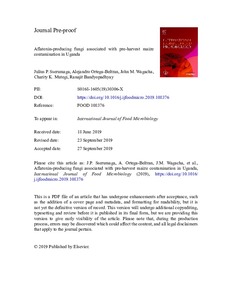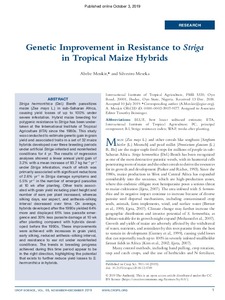Welcome to the International Institute of Tropical Agriculture Research Repository
Journal and Journal Articles: Recent submissions
Now showing items 1141-1160 of 5157
-
Monitoring Aspergillus flavus genotypes in a multi-genotype aflatoxin biocontrol product with quantitative pyrosequencing
(2019)Aflatoxins pose significant food security and public health risks, decrease productivity and profitability of animal industries, and hamper trade. To minimize aflatoxin contamination in several crops, a biocontrol technology based on atoxigenic strains of Aspergillus flavus is commercially used in the United States and some African countries. Significant efforts are underway to popularize the use of biocontrol in Africa by various means including incentives. The purpose of this study was to develop ... -
Micro-livestock in smallholder farming systems: the role, challenges and opportunities for cavies in South Kivu, eastern DR Congo
(2020)Livestock play multiple roles for smallholder farmers in sub-Saharan Africa. Mixed crop-livestock systems are common in South Kivu, eastern DR Congo, but herd sizes are small and numbers of large livestock (i.e. cattle) have declined, due to high population density, recent conflicts and extreme poverty. Over half of the farmers keep cavies, a type of micro-livestock fitting the circumstances of smallholders and a valuable asset especially for the poorest households. To characterize cavy husbandry ... -
Chromosome painting facilitates anchoring reference genome sequence to chromosomes in situ and integrated karyotyping in banana (Musa spp.)
(2019)Oligo painting FISH was established to identify all chromosomes in banana (Musa spp.) and to anchor pseudomolecules of reference genome sequence of Musa acuminata spp. malaccensis “DH Pahang” to individual chromosomes in situ. A total of 19 chromosome/chromosome-arm specific oligo painting probes were developed and were shown to be suitable for molecular cytogenetic studies in genus Musa. For the first time, molecular karyotypes of diploid M. acuminata spp. malaccensis (A genome), M. balbisiana ... -
Host plants and edaphic factors influence the distribution and diversity of ectomycorrhizal fungal fruiting bodies within rainforests from Tshopo, Democratic Republic of the Congo
(2019)Ectomycorrhizal fungi constitute an important component of forest ecosystems that enhances plant nutrition and resistance against stresses. Diversity of ectomycorrhizal (EcM) fungi is, however, affected by host plant diversity and soil heterogeneity. This study provides information about the influence of host plants and soil resources on the diversity of ectomycorrhizal fungal fruiting bodies from rainforests of the Democratic Republic of the Congo. Based on the presence of fungal fruiting bodies, ... -
"Ground-truthing" efficacy of biological control for aflatoxin mitigation in farmers' fields in Nigeria: from field trials to commercial usage, a 10-year study
(2019)In sub-Saharan Africa (SSA), diverse fungi belonging to Aspergillus section Flavi frequently contaminate staple crops with aflatoxins. Aflatoxins negatively impact health, income, trade, food security, and development sectors. Aspergillus flavus is the most common causal agent of contamination. However, certain A. flavus genotypes do not produce aflatoxins (i.e., are atoxigenic). An aflatoxin biocontrol technology employing atoxigenic genotypes to limit crop contamination was developed in the ... -
Genetic correlation, genome-wide association and genomic prediction of portable NIRS predicted carotenoids in cassava roots
(2019)Random forests (RF) was used to correlate spectral responses to known wet chemistry carotenoid concentrations including total carotenoid content (TCC), all-trans β-carotene (ATBC), violaxanthin (VIO), lutein (LUT), 15-cis beta-carotene (15CBC), 13-cis beta-carotene (13CBC), alpha-carotene (AC), 9-cis beta-carotene (9CBC), and phytoene (PHY) from laboratory analysis of 173 cassava root samples in Columbia. The cross-validated correlations between the actual and estimated carotenoid values using RF ... -
Food access deficiencies in sub-Saharan African: prevalence and implications for agricultural interventions
(2019)Our understanding of food security in sub-Saharan Africa (SSA) has been hampered by limitations in the temporal and spatial representativeness of data. Food balance sheets provide scalable estimates of per capita food availability, but fail to represent food access, stability and their causal linkages. In contrast, rural household surveys represent detailed conditions for one or multiple points in time, but are influenced by survey timing and are often limited in geographical coverage. This study ... -
Factors influencing participation dynamics in research for development interventions with multi-stakeholder platforms: a metric approach to studying stakeholder participation
(2019)Multi-stakeholder platforms have become mainstream in projects, programmes and policy interventions aiming to improve innovation and livelihoods systems, i.e. research for development interventions in low- and middle-income contexts. However, the evidence for multistakeholder platforms’ contribution to the performance of research for development interventions and their added value is not compelling. This paper focuses on stakeholder participation as one of the channels for multi-stakeholder ... -
Evaluation of the American yam bean (Pachyrhizus spp.) for storage root yield across varying eco-geographic conditions in Uganda
(2019)The American yam bean (Pachyrhizus spp.) is a legume crop that is exclusively used for its storage roots. The seeds are inedible due to presence of toxic rotenone. It produces high storage root yields comparable of major root crops like cassava or sweetpotato. And flower pruning more than doubles its root yield performance. Using twenty five yam bean accessions, the current study aimed to determine root yield stability and adaptability, and presence of yam bean production mega environments in ... -
Distribution of Pseudocercospora species causing Sigatoka leaf diseases of banana in Uganda and Tanzania
(2020-01)Sigatoka leaf diseases are a major constraint to banana production. A survey was conducted in Tanzania and Uganda to assess the distribution of Pseudocercospora species and severity of Sigatoka leaf diseases. Pseudocercospora species were identified using species‐specific primers. Sigatoka‐like leaf diseases were observed in all farms and on all cultivars, but disease severity varied significantly (P < 0.001) between countries, districts/regions within countries, altitudinal ranges and banana ... -
Distribution and diversity of viruses infecting yams (Dioscorea spp.) in Cameroon
(2019-12)Yam (Dioscorea spp.) is an important food crop cultivated for its edible tubers in Cameroon. Surveys were conducted in Cameroon to determine the incidence and severity of yam mosaic disease and associated viruses in 124 yam farms in four agro-ecological zones in 2014 and 2016. Dioscorea rotundata, D. cayenensis, D. alata, D. Dumetorum and D. bulbifera were most frequently detected yam species in the fields. Symptoms of virus disease were observed on 81.5% of the farms surveyed and the disease ... -
Changes in heterosis of maize (Zea mays L.) varietal cross hybrids after four cycles of reciprocal recurrent selection
(2019)Two improved tropical maize composites, TZL COMP3 and TZL COMP4; representing complementary heterotic pools have been subjected to four cycles of reciprocal recurrent selection (RRS) for two decades to enhance varietal cross performance. The objectives of this study were to evaluate the effect of selection on genetic gain in heterosis for grain yield and other agronomic traits of these composites. Ten parental populations representing the C0 to C4 of each composite and their crosses plus a varietal ... -
Assessment of genetic diversity for drought, heat and combined drought and heat stress tolerance in early maturing maize landraces
(2019)Climate change is expected to aggravate the effects of drought, heat and combined drought and heat stresses. An important step in developing ‘climate smart’ maize varieties is to identify germplasm with good levels of tolerance to the abiotic stresses. The primary objective of this study was to identify landraces with combined high yield potential and desirable secondary traits under drought, heat and combined drought and heat stresses. Thirty-three landraces from Burkina Faso (6), Ghana (6) and ... -
A simple and rapid protocol for the genetic transformation of Ensete ventricosum
(2019-12)Enset (Ensete ventricosum), also known as Ethiopian banana, is a food security crop for more than 20 million people in Ethiopia. As conventional breeding of enset is very challenging, genetic engineering is an alternative option to introduce important traits such as enhanced disease resistance and nutritional value. Genetic transformation and subsequent regeneration of transgenic enset has never been reported mainly due to challenges in developing transformation protocols for this tropical species. ... -
A detached leaf assay to rapidly screen for resistance of maize to Bipolaris maydis, the causal agent of southern corn leaf blight
(2019)Southern corn leaf blight (SCLB), caused by the fungus Bipolaris maydis, is a disease that significantly affects maize productivity across the globe. A detached leaf assay (DLA) was developed to rapidly assess maize resistance to SCLB. Several experiments were conducted to: (i) identify a highly virulent B. maydis isolate; and to determine the most appropriate (ii) phytohormone to maintain viability of maize leaf tissue, (iii) leaf age for the assay, and (iv) inoculum concentration. Once optimized, ... -
Diagnosis of crop secondary and micro-nutrient deficiencies in sub-Saharan Africa
(2019)Crop production in sub-Saharan Africa has numerous biotic and abiotic constraints, including nutrient deficiencies. Information on crop response to macronutrients is relatively abundant compared with secondary and micronutrients (SMN). Data from 1339 trial replicates of 280 field trials conducted from 2013 to 2016 in 11 countries were analyzed for the diagnosis of SMN deficiencies. The diagnostic data included relative yield response (RYR) and soil and foliar test results. The RYR to application ... -
Combining ability for grain yield, agronomic traits and striga hermonthica resistance of yellow endosperm maize
(2018)Maize production is constrained by Striga hermonthica in Mali leading to high yield losses. Breeding resistant hybrid maize is a promising alternative for increasing farmers’ income. The objective of this study was to evaluate the response of test crosses to Striga hermonthica and identify high yielding and adopted hybrid. Forty-five F1 hybrids and three checks were evaluated under Striga-infested and Striga-free conditions in Sanankoroba and Sotuba rainy season. Data collection was carried on ... -
Aflatoxin-producing fungi associated with pre-harvest maize contamination in Uganda
(2020-01)Maize is an important staple crop for the majority of the population in Uganda. However, in tropical and subtropical climates, maize is frequently contaminated with aflatoxins, a group of cancer-causing and immuno-suppressive mycotoxins produced by Aspergillus section Flavi fungi. In Uganda, there is limited knowledge about the causal agents of aflatoxin contamination. The current study determined both the aflatoxin levels in pre-harvest maize across Uganda and the structures of communities of ... -
Genetic diversity of Ethiopian cowpea [Vigna unguiculata (L) Walp] genotypes using multivariate analyses
(2019)Cowpea is a multipurpose pulse crop grown by poor farmers in marginal and drought prone areas of Ethiopia. Information on the extent of genetic variation in cowpea genotypes is crucial to identify diverse genotypes for crop improvement and for efficient utilization of the existing genetic resources. Therefore, the objectives of the study were to assess the extent and pattern of morphological diversity among cowpea genotypes and to identify the traits contributing to the genetic diversity using ... -
Genetic improvement in resistance to Striga in tropical maize hybrids
(2019-11)Striga hermonthica (Del.) Benth parasitizes maize (Zea mays L.) in sub‐Saharan Africa, causing yield losses of up to 100% under severe infestation. Hybrid maize breeding for polygenic resistance to Striga has been undertaken at the International Institute of Tropical Agriculture (IITA) since the 1980s. This study was conducted to estimate genetic gain in grain yield and associated traits in a set of 32 maize hybrids developed over three breeding periods under artificial Striga ‐infested and ...

